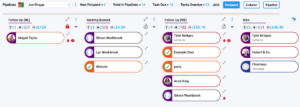popcorn is designed to aid you in making your business grow. It makes your business easier to manage, stores essential information, and helps you spot golden nuggets in your database. As you can create and manage email campaigns from popcorn’s software, here’s our guide to making a good email campaign.
Best Email Campaign: First Things First
Plans
Taking an overview of what you want to achieve is an essential first step to constructing your campaign. There are six main sections you need to consider when constructing your plan:
Objective
What is your objective? Try and be as specific as possible. For example, ‘a 15% increase in clickthroughs to the website over a period of three months’ is a clear objective. It allows you to check your analytics and see real, quantifiable growth.
Messaging
What is the message you want to convey? Is the campaign about a particular topic, product, or aim? When deciding this, consider how your audience view you at the moment. How do you want them to view you by the end of it?
Content
What sort of content you are able to make? This includes how much, and what mediums you’re using. We recommend providing a variety of content in order to keep your audience engaged. Switch it up between articles, videos, webinars, infographics, etc. This will prevent your audience from falling into a lull, and help you avoid disengagement.
Email Formats
In the same way, you need to plan what your email formats will be. Having different formats, with different aims, can bring together the different strands of your campaign. For example, if your campaign is about social media growth, then you could centre one email around a new video you’re releasing. Afterwards, send another reminding your audience about a page you want them to visit. Another could be about feedback. Like with your content production, the aim here is to provide variety. Keep your audience engaged, and reduce unsubscribe rates.
Realism
Remember to be realistic about what you can achieve. How much time do you have to prepare? And how much time will you have during the email campaign? Making sure everything can logically be made to the best of your ability will give you confidence in your work. Implement this approach in your objectives to the software you use for content creation. From this, you’ll prevent stress during the execution of your campaign.
Structure
Visualising and structuring a plan for your email campaign is a crucial aspect of avoiding undue stress. Knowing what goes where and when will help you (and your team) throughout the process. You’ll be able to account and rectify any errors, mistakes or unexpected difficulties that may pop up. It means you’re never on the back foot. Our free training course has a section that focuses specifically on how to make a good plan.
Testing and Measuring
All of the above are ultimately factors that can be tested and measured against. Of course, you’ll be actually testing and measuring against certain metrics that align with your topic. If the feedback you’re getting isn’t optimal, adjusting mid-campaign might give you the results you need. Constantly reviewing how your strategy and plans are going is never a bad thing.
As marketers, we are always looking to improve our skills as well as the work we’re putting out. You can always learn, even and especially during a campaign.
A Comprehensive Contact List
A successful campaign is as dependent on your contact list as it is on the content you put out. You don’t just want your readers to be interested: you want them to know that what they’re going to read is going to be valuable. They’ll be curious, and encouraged to take more actions.
The requirement is that you align your content with their interests. If they’re not going to be interested by what you have to say, then why are you saying it? All you’ll get in return is a low open rate and high unsubscribe rate.
Making sure the right people are getting your emails is the number one priority. Go through your tags and select the people whose tags have similar sentiments to the campaign topic. This is that guarantee of value added. People will want to hear you.
Of course, that doesn’t guarantee that everyone will open your emails. Some will still unsubscribe. But it does reduce that number specifically.
Another key action for your contact list is to check whether your email bounced. Hard bounces are not a priority as popcorn automatically takes them off your contact list and you cannot send them email in the future. However, if you are getting consistent soft bounces from an email address, then you need to consider taking them off the list. It’s no skin off your nose, and none off theirs.
Frequency
By sending out multiple emails, you do run the risk of bombarding your contacts with content. Truthfully, there’s no easy answer for how many emails you should send out. That’s because it’s dependent on the campaign, and who you’re targeting.
You may want to send out more emails if you know you’re competing in inboxes that will often get full. At the same time, you don’t want to send so many—multiple in a week—that it turns your contact off. On the flip side, you don’t want to send so few that they forget about you completely.
The best way to attack this problem is by testing and measuring. This will give you more of a comprehensive answer than any blog post.
If you want to find out more, you can read our article that breaks down when to send emails further. Or, you can watch popcorn founder Simon Washbrook’s video on this topic.
Anticipation
As you’re basing an email campaign around a particular topic, it makes sense that you’ll produce multiple pieces of content. You need to make clear to your readers that more is on its way. Otherwise, they could treat it as a one-off and lose interest in the upcoming emails. A little anticipation goes a great way to retaining or improving your open rate.
You can do this by setting out what is to come in the main content of your email. This can be early on in the campaign or as a repeated section in every email afterwards. Or, you can add a tagline at the end of your email simply to let your reader know of next week’s contents. This signposting and linking will encourage your reader to explore more of the campaign. And this can only mean good things!
A good trick is not just to create anticipation—let your readers create it for themselves. Asking them what they want to learn about next can help hugely. Not only do your readers feel part of a community, you are given an opportunity to curate your content towards your audience even more.
Best Email Campaign: Formatting
Branding
We’ve talked about having a variety of email and content formats already, but the advice doesn’t stop there for emails.
Always keep your emails consistent. By this, I mainly mean branding. You will likely be keeping the content of your emails consistent regardless, as you’ll be pushing out an overarching subject for a campaign. But the presentation of your email campaign is also paramount.
People appreciate knowing who an email is from. They appreciate professionalism and capability. Messing up your branding or switching it regularly not only confuses the reader about who is sending them emails, it reduces reader confidence. This reduces your click/open rates as they won’t be sure they’re being directed to a legitimate site. Plus, solidifying your brand in their minds means you are likely to be their first choice when they need to buy.
popcorn’s drag and drop editor allows you to add your branding to your emails, by way of images, fonts and positioning. You can also save an email as a template, so you don’t have to go through the same process again. This is especially helpful when constructing campaigns!
Humanisation
As any marketer worth their salt knows, customers don’t want to buy from a brand. People buy from people—so make sure your contacts are aware of who you are.
Treat your email campaign like a conversation. Instead of shouting at someone what you want to sell them, greet them. Ask them how they are. Keep your tone light and friendly. If there’s something happening where they are, then why not mention it? An example of this might be a snow storm blanketing the entire nation, which is enough of a phenomenon in the UK to chat about! You could start the main body of your email with, ‘Hope you’re keeping warm!’ Or ‘While you’re hurriedly finding multiple blankets to hide under, have you thought…’
Signing off as a human instead of ‘The Company’ helps build a parasocial relationship between you and those contacts. A connection, however vague, will connect your contacts to an employee, thus to the brand. This also applies to the email address that your emails are sent from. If they can recognise you, they can remember you.

Short and Sweet
The truth is that readers don’t want to hang around for long. Emails are short sprints, not marathons.
So keep them that way. Don’t make your readers work for the value; it can make them decide that there isn’t much value in the email at all, and won’t bother to read the rest. Meanwhile, they will have missed out on something that could benefit them, and you have missed out on an opportunity.
Being straight to the point doesn’t mean your emails can’t be creative. For a start, you have to modify your tone depending on what your email campaign is about. Secondly, you can still have fun with the words—there just happen to be less characters. What matters in the end is getting your readers to where you want them to go: to your links, your website, your forms, etc., where you can reinforce your brand and sales message. Encouraging them to earn your content—making them work to access it, but not too much that they’re put off—will tell you what they’re willing to invest effort in.
You may have plenty more to say, but that can be said further down the line, or in person if your business with a contact gets that far.
Encouraging Links
This is a basic of email marketing, but if you want to drive traffic, then put links in your emails! But don’t inundate your readers. If everything is a link, or a ‘CLICK HERE’, then that can be confusing and overwhelming. As soon as you’ve overwhelmed your reader, you’ve lost them.
You want to guide them, not lose them. You want to give off the impression that you are a bastion of business; a curator of content. Showing off what you’ve already produced will give your contacts more options. Though they may not engage with the main content you want them to follow, clicking on another link will at least cement the memory of this email in their heads. It is likely they will find their way to the main content in question at another point in time, either by returning to this email or otherwise.
Unsubscribe Link
Of course, you don’t actually want them to unsubscribe, but you are required by law (GDPR) to give them the option. Try looking at this as a positive: if you see your unsubscribe rate going up, it means you have an opportunity to change and refine what you are sharing with your readers.
Readers need to feel in control. This can be done by clicking out of the email, or simply ignoring it, but unsubscribing is a more final, active response.
This doesn’t mean their business with you has ended for good, either. They are still likely to remember your company, so may choose to return at any point.
Have any more questions about email marketing? You can visit our Getting Started page, or read our email marketing posts on our blog.











